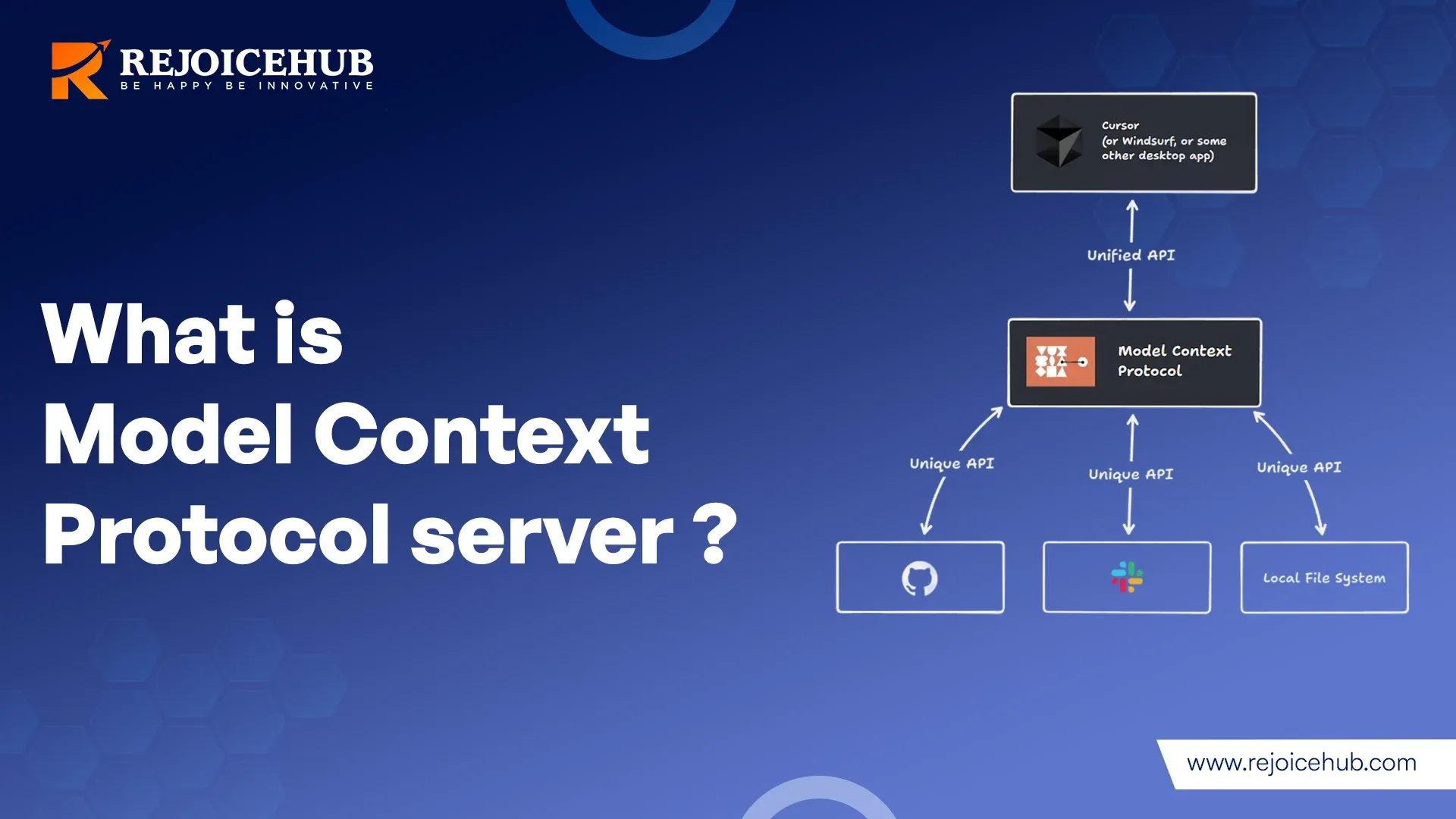 AI tools are impressive, but they aren't very useful unless they can access information beyond their training data. Most AI models work in isolation, they can talk about your calendar, but they can't actually check it.
AI tools are impressive, but they aren't very useful unless they can access information beyond their training data. Most AI models work in isolation, they can talk about your calendar, but they can't actually check it.
Meet Model Context Protocol server (MCP) - an open standard that connects AI models to your tools and data. Want your AI assistant to check your calendar, access your files, or send emails for you? MCP makes this possible.
Quick Summary
MCP is an open protocol that standardizes how AI applications connect to data and tools. Think of it as a USB-C port for AI - just as USB-C connects your devices to various sources, MCP connects AI models to different tools and data sources.
Originally developed by Anthropic (the company behind Claude), MCP has been adopted by OpenAI and other major AI platforms. It makes it an emerging industry standard.
What is MCP?
MCP is a two-way communication bridge between AI assistants and external tools. It gives AI models access to outside information and lets them take action in those systems.
Instead of building custom integrations for every service, MCP creates standard rules for how AI systems talk to external tools. It defines how they communicate, structure requests, and discover available features.
This means developers can quickly connect AI models to external tools without starting from scratch each time. For users, it means AI assistants that understand your context and help you get real work done.
How does MCP work?
MCP uses a client-server setup for safe talks between AI models and outside systems. When you ask an AI to 'check my calendar,' it uses MCP to talk to your calendar tool. It gets your plan. It gives back facts in a way it can grasp.
The AI doesn't need to know how your calendar works. It just needs to know a calendar tool can be used through MCP. It needs to know what this tool can do. This makes plug-and-play use work across many tools.
What problem is MCP solving?
AI tools are only as useful as the data they can access and the actions they can take. Without external connections, AI assistants can only answer general questions and perform basic tasks.
Think about these scenarios:
- Checking your company's sales figures compared to last quarter
- Updating customer records in your CRM
- Scheduling meetings based on your availability
Without MCP, each task needs custom integration between your AI and each application. MCP fixes this by giving AI systems a standard way to discover and use external tools.
MCP bridges understanding and action, allowing AI to not just provide insights but actually get things done in your everyday apps.
Architecture of MCP
The architecture of MCP (Model-Centric Programming) is designed to integrate AI models with external tools and data sources seamlessly. At its core, MCP enables AI systems to interact with real-world environments by establishing standardized interfaces for data exchange and task execution. MCP uses a client-server structure with these key parts:
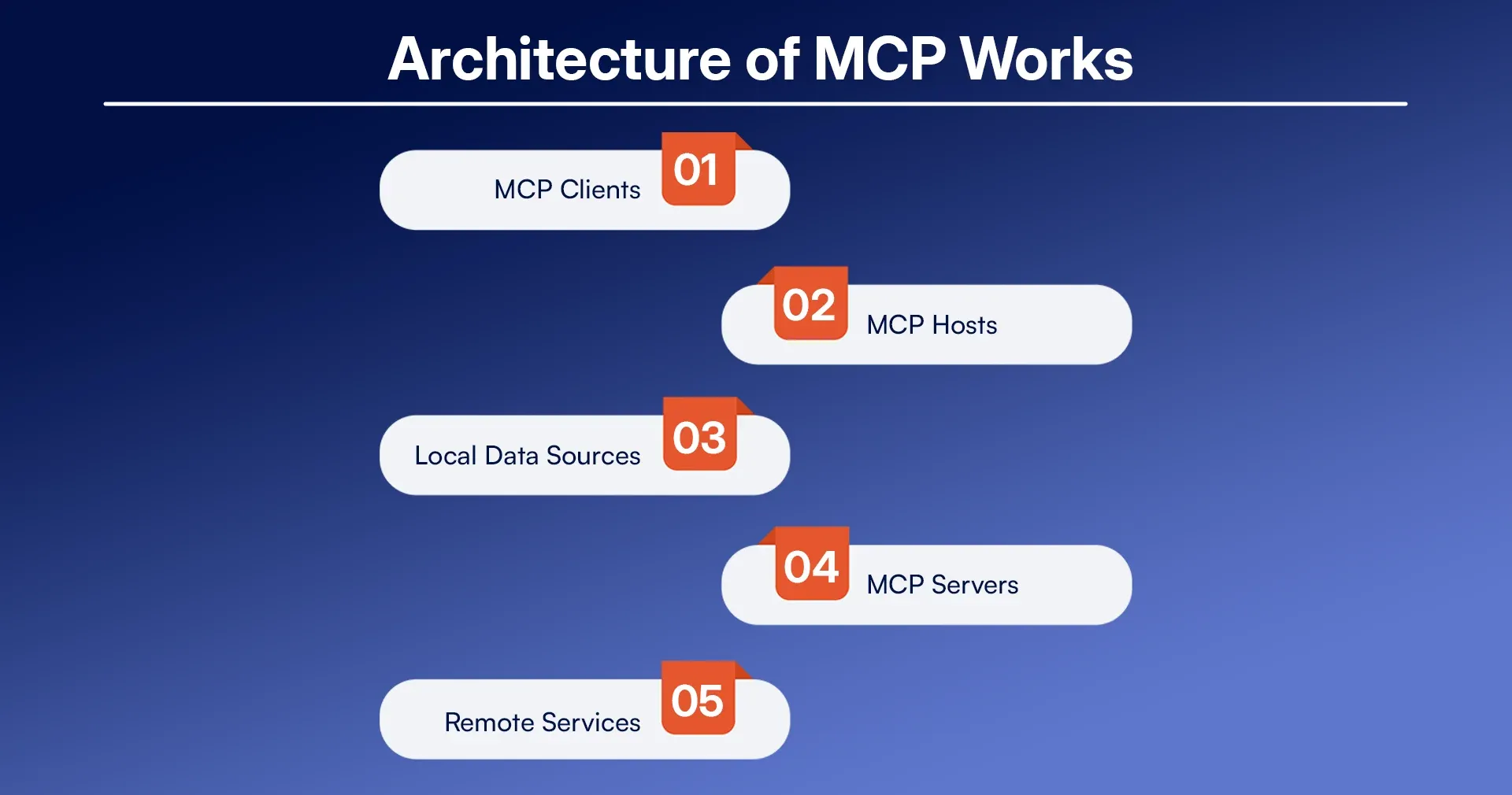
1. MCP Hosts
These are apps that work as main leaders in the MCP system. They are often AI tools like chat bots, code spaces, or other AI apps that need outside facts. The host runs client links. It sets safety rules. Some examples are Claude Desktop, AI code tools, or custom AI apps.
2. MCP Clients
Started by the host, MCP clients keep one-to-one links with MCP servers. They handle all talk between host and server. They make sure data moves safely. The client reads what the host asks. It sends these asks to the right server.
3. MCP Servers
These are small apps that give set tools through the MCP system. Each server links to a data source or tool. It gives set ways to use its jobs. For example, a server tied to file saving might let you 'look for files' or 'read files.' One tied to team chat might let you 'see notes' or 'change status.'
4. Local Data Sources
These are files, data sets, or tools on your own computer or safe work net that MCP servers can use. This means your files, local data sets, or inside work tools.
5. Remote Services
These are web-based systems, often used through APIs, that MCP servers link to. Some examples are cloud tools, web apps, or public APIs for weather facts, stocks, or other outside info.
MCP servers provide data through three main methods:
- Prompts: Ready-made templates you can select with commands or menu options
- Resources: Structured data like files or database records that add context
- Tools: Functions that let the AI take action, like using an API or saving a file
Also Read: Best AI Agents for Business to Improve Productivity in 2025
Benefits of implementing MCP
Implementing MCP (Model-Centric Programming) brings several key benefits, including seamless integration of AI systems with external data and tools, enhanced context understanding, and improved task completion accuracy. It enables the creation of AI assistants that are highly adaptable, boosting productivity and streamlining workflows. By adopting MCP, businesses can stay at the forefront of AI innovation, ensuring their applications are more efficient, reliable, and scalable.
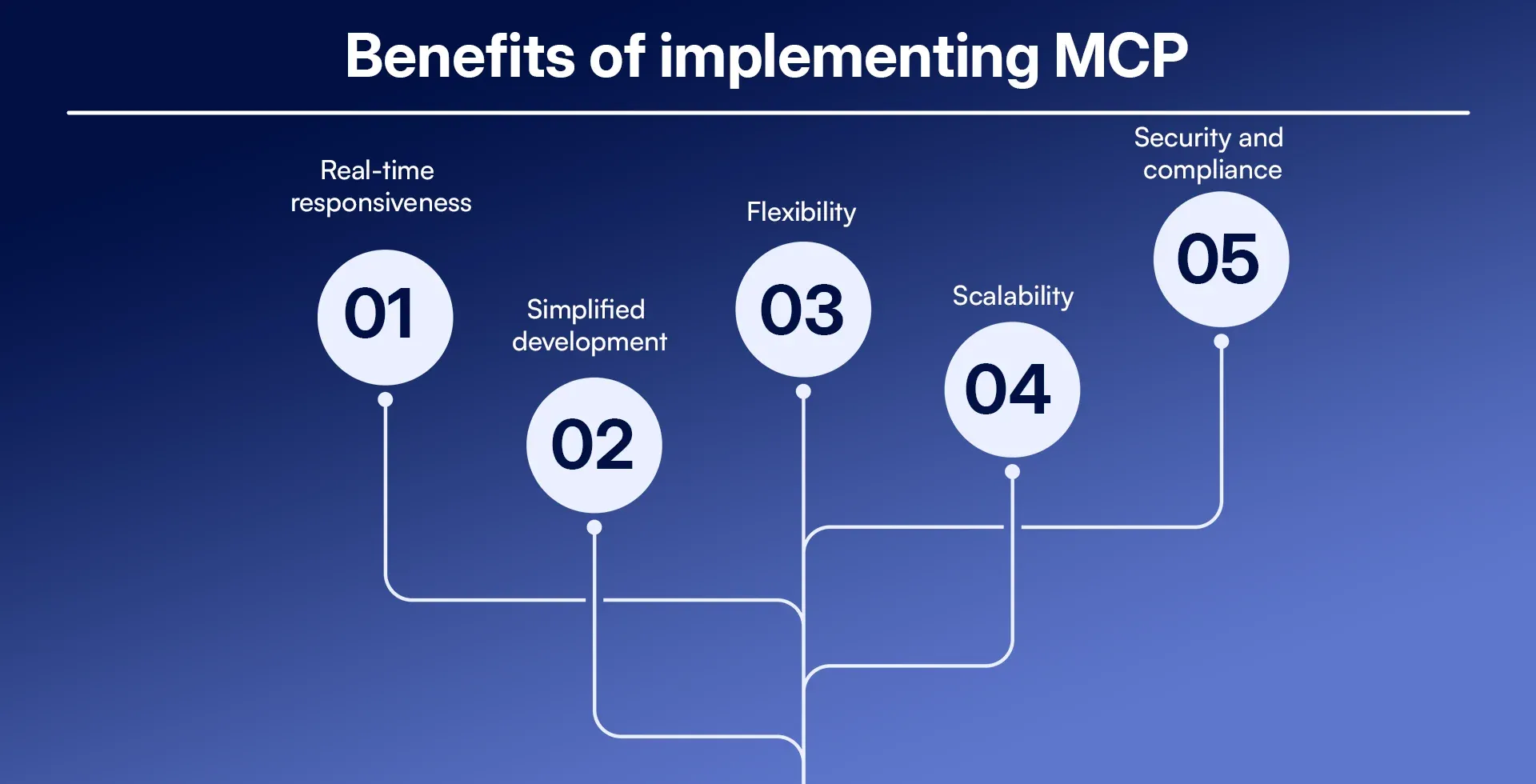
1. Real-time responsiveness
MCP connections stay active, allowing instant updates and interactions. This means AI assistants get updates from systems as they happen and respond with the latest information.
2. Simplified development
With MCP, developers write code once and connect to multiple systems without custom code for each one. This cuts development time and maintenance work, especially when using many external services.
3. Flexibility
MCP lets you switch between AI models or tools easily. If you change AI providers or swap one tool for another, the standard MCP approach makes transitions smooth.
4. Scalability
As you grow, you can add new features by connecting more MCP servers. This modular design lets you start small and expand your AI capabilities without major system changes.
5. Security and compliance
MCP has built-in access controls and standard security practices. This ensures connections between AI systems and external tools meet your security requirements and compliance needs.
When to use MCP?
MCP (Model-Connected Protocol) should be used when you want to enhance your AI system's ability to interact with external data and tools seamlessly. MCP works best when you need AI that understands context and works with multiple systems. Here are three key use cases:
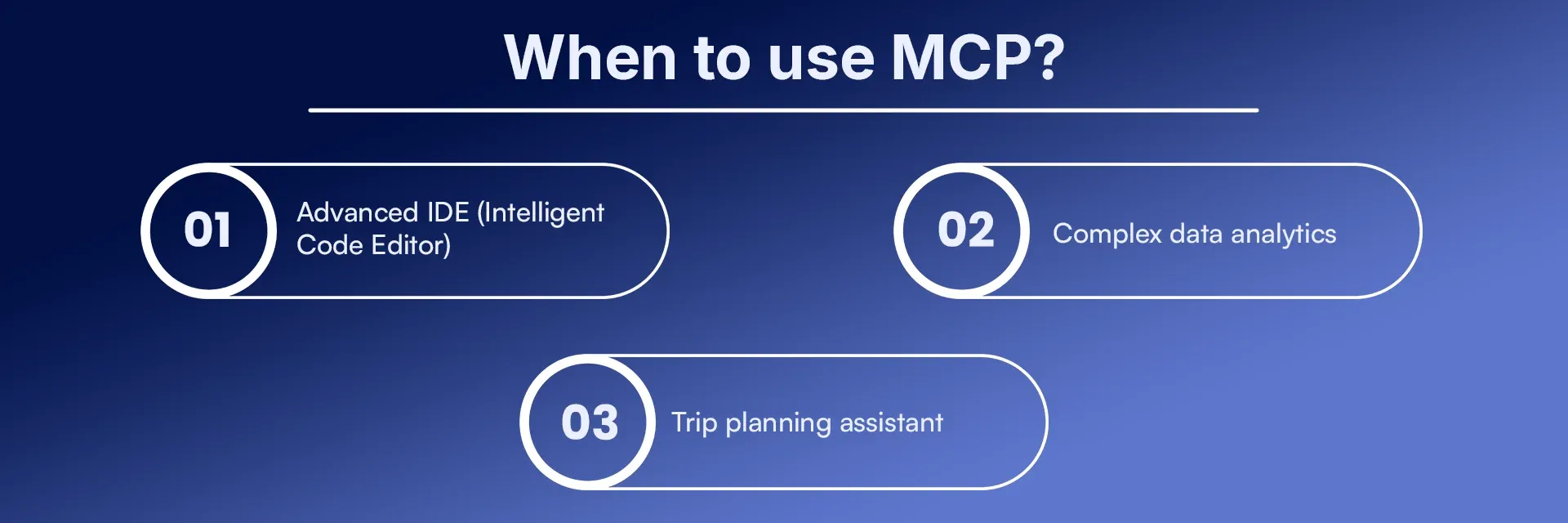
1. Advanced IDE (Intelligent Code Editor)
Traditional approach: Manually connect your IDE to file systems, version control, package managers, and documentation, each needing custom code.
MCP approach: Your IDE connects to all these systems through one MCP protocol. The AI understands your code, suggests improvements, documents automatically, and deploys changes—all through standard MCP connections.
2. Complex data analytics
Traditional approach: Manually connect to each database and visualization tool with custom code for each one.
MCP approach: Your AI analytics tool finds and works with multiple databases and visualizations through one MCP layer. It pulls data from different sources, transforms it, and creates visuals without custom code for each step.
3. Trip planning assistant
Traditional approach: Write separate code for calendar, email, flight booking, and hotel systems, each with custom authentication and error handling.
MCP approach: Your AI assistant checks your calendar, books flights and hotels matching your preferences, and emails confirmations all through MCP servers, with no custom integrations for each travel service.
Also Read: What is Simple Reflex Agents in AI?
How to get started with MCP?
To get started with MCP (Model-Connected Protocol), begin by understanding its core principles and how it enables seamless integration between AI models and external tools. You can start by exploring available pre-built integrations and APIs. Getting started with MCP takes just a few key steps:
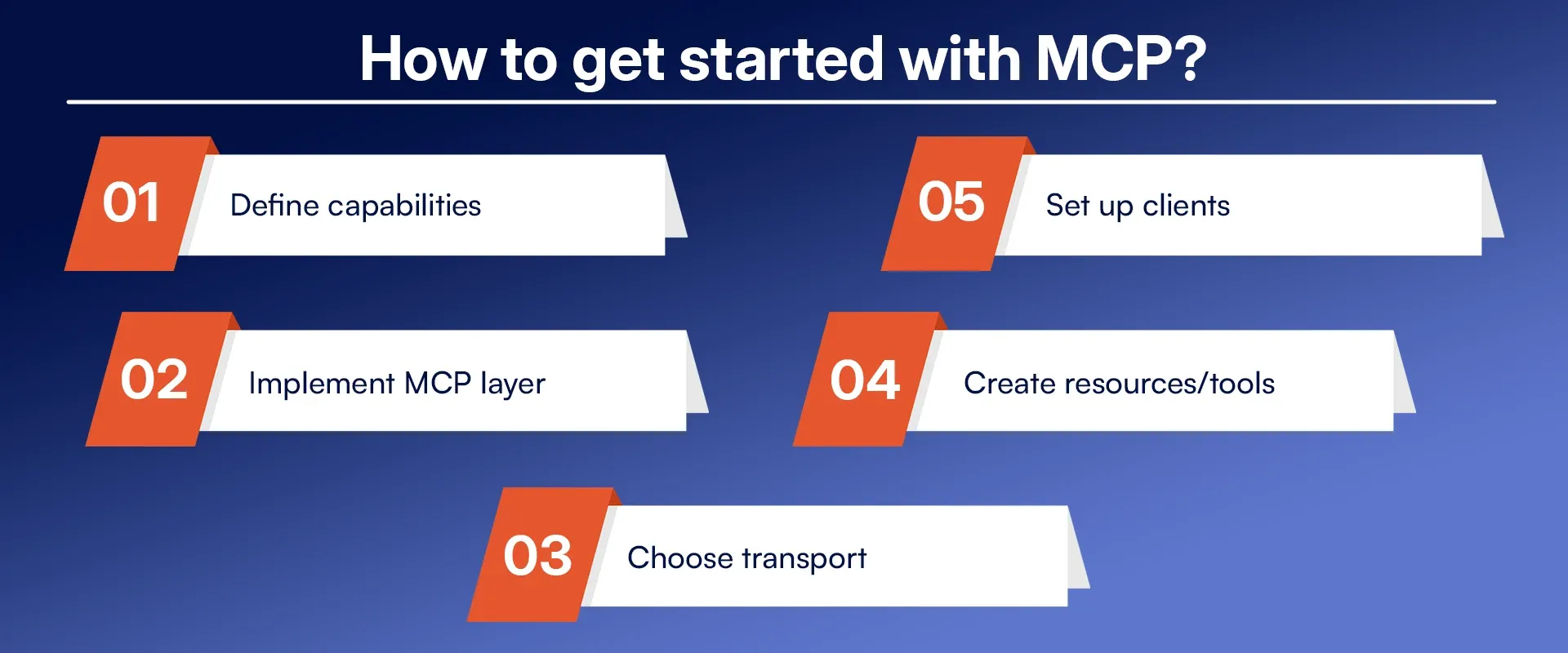
1. Define capabilities
Clearly list what your MCP server will do. Will it access files? Get calendar data? Send messages? Defining these features upfront ensures your MCP meets your needs.
2. Implement MCP layer
Follow the standard MCP protocol specs when building. This ensures your system works with existing MCP clients and servers. Use available SDKs (including the new C# SDK) to speed up development.
3. Choose transport
Pick between local (stdio) or remote (Server-Sent Events/WebSockets) transport methods. This depends on whether your MCP server will run on the same machine as the client or across a network.
4. Create resources/tools
Build or connect the specific data sources and services your MCP will use. This might mean writing adapters for existing APIs or creating interfaces to internal systems.
5. Set up clients
Create secure connections between your MCP servers and clients. Set up proper authentication so only authorized users and apps can access your MCP servers.
Key differences between MCP and traditional APIs
MCP (Model Command Protocol) is designed to integrate AI models with external tools and data in a standardized way. Unlike traditional APIs, which are often used for point-to-point communication between software systems, MCP enables AI models to interact with various external sources dynamically, allowing for more context-aware decision-making. While MCP might seem similar to traditional APIs, they differ in key ways:

1. Dynamic discovery
MCP lets AI models find and use available tools without knowing about each integration in advance. This means the AI adapts to whatever tools are available without needing updates to its core code.
2. Two-way communication
MCP supports ongoing, real-time two-way communication (like WebSockets). The AI can both get information and trigger actions dynamically, creating more responsive experiences.
3. Single protocol
MCP works as a standard connector, so one MCP integration gives access to multiple tools and services. This cuts integration work compared to traditional APIs, where each service needs separate integration.
Traditional APIs work better when you need precise control, tight coupling for performance, or complete predictability. For AI applications needing flexibility, MCP offers a more powerful alternative.
Conclusion
MCP marks a major advance in making AI systems more useful in real-world settings. By creating a standard way for AI models to work with external data and tools, MCP helps build AI assistants that truly understand your context and help complete real tasks.
The MCP ecosystem is growing fast. With Anthropic and OpenAI supporting the standard and more pre-built integrations becoming available, we're getting closer to AI assistants that fit seamlessly into our digital work and life.
Whether you’re developing next-gen AI applications or looking to boost productivity with AI assistants, MCP provides the foundation for the future of AI integration. RejoiceHub offers specialized MCP development services, helping businesses harness the full potential of AI-powered systems.
Frequently Asked Questions
Is MCP only for developers, or can non-technical users benefit from it?
While implementing MCP requires technical skills, non-technical users benefit from AI tools that use MCP. If you're not a developer, look for AI apps that support MCP.
Does using MCP make my AI tool an 'AI agent'?
Not automatically. MCP enables agent-like behavior by letting AI access systems and take actions, but it doesn't make any AI an 'agent.' It's just a connection protocol.
How does MCP handle security concerns?
MCP has built-in authentication, authorization, and secure data transfer. MCP servers can also run locally in your secure environment, keeping sensitive data inside your infrastructure.
Which companies support MCP?
MCP was created by Anthropic (makers of Claude) and is now supported by OpenAI and platforms like Zapier, Replit, Sourcegraph, and Windsurf.
How does MCP differ from other AI integration approaches?
Unlike proprietary systems, MCP is an open standard that works across different AI models and tools. It's more flexible and standardized than custom API integrations or plugin systems.
Where can I learn more about implementing MCP?
Visit modelcontextprotocol.io for guides, examples, and resources to start with MCP. You'll find example servers, client implementations, and tutorials to help you.
